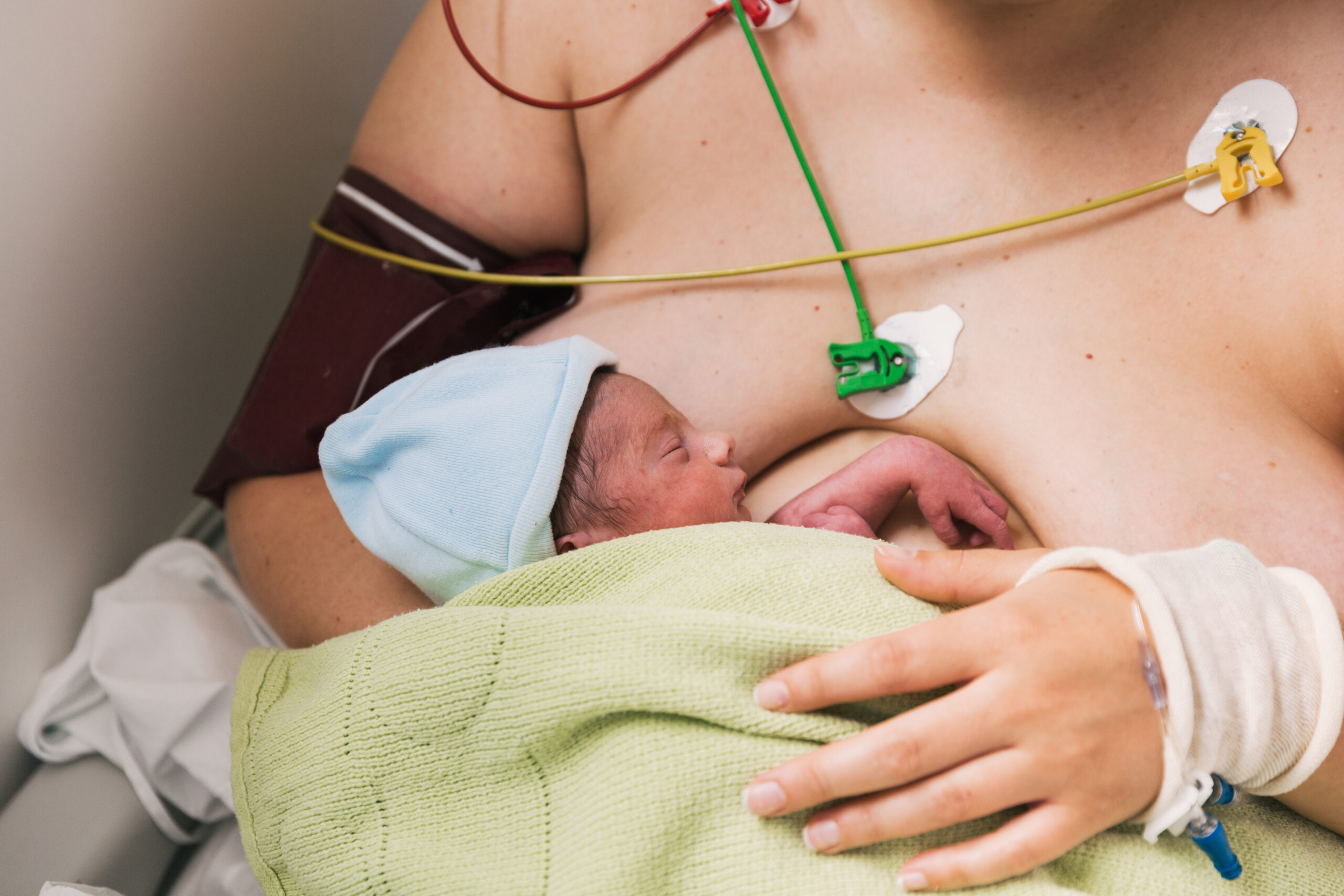Birth and breastfeeding are beautifully linked – both powered by the amazing hormone Oxytocin, also referred to as the ‘love hormone’. This hormone is essential for birth, breastfeeding and bonding but did you know your birth experience can impact the production of Oxytocin?
As a mum, midwife, health visitor, and hypnobirthing teacher, I’ve seen how the way we give birth can influence those first hours and days of breastfeeding. I have witnessed women struggle with breastfeeding and feel so disheartened they give up in those first few days, thinking their baby is hungry and worried they don’t have enough milk.
As a mum, midwife, health visitor, and hypnobirthing teacher, I’ve seen how the way we give birth can influence those first hours and days of breastfeeding.

I am here to help you understand not in a “you can’t breastfeed if…” way – but in a realistic, supportive way that helps you have realistic expectations so you can understand and adapt.
How common birth interventions like induction, synthetic oxytocin, caesarean birth, and drugs such as Syntometrine can affect early breastfeeding.
Why this doesn’t mean breastfeeding won’t work — it might just take a little more time and support.
Practical steps you can take postnatally to support milk coming in.
How hypnobirthing helps you make informed birth choices and stay calm even when things don’t go to plan.
How Birth Interventions Can Affect Breastfeeding
Birth is a delicate hormonal dance. Oxytocin — the “love hormone” — drives both labour contractions and delivery of your baby and placenta, it signals the let-down reflex that releases breast milk and helps you bond with your baby. When labour interventions occur such as Induction of Labour, Active Management of your placenta or Cesarean Section it can affect this natural production of Oxytocin.
Induction and Synthetic Oxytocin
Research shows that induction of labour and the use of synthetic oxytocin (Syntocinon) are linked to slightly higher rates of delayed breastfeeding initiation and shorter breastfeeding duration (International Breastfeeding Journal, 2022).
This is because synthetic oxytocin doesn’t cross the blood–brain barrier in the same way as your natural oxytocin — so while it helps your uterus contract, it doesn’t trigger the same “love-bonding” response that supports early milk flow and maternal calm.
Syntometrine (Used in Active Management to Deliver the Placenta)
Syntometrine contains ergometrine, which helps the uterus contract after birth. Studies have shown that ergometrine can temporarily suppress prolactin — the hormone that kickstarts milk production (PubMed ). This doesn’t mean your milk won’t come in, but it can delay that day-3–5 fullness slightly.
Caesarean Birth
Drugs used in Cesarean Section can also inhibit natural Oxytocin. Another issue with caesarean section can be a delay in skin-to-skin and first feeds simply because of recovery, pain relief, or separation. One large study found that mothers who had pre-labour caesareans were less likely to be exclusively breastfeeding at discharge and 3 months postpartum (International Breastfeeding Journal, 2022).
But again — awareness helps. With support, skin-to-skin, and patience, you can absolutely establish a strong breastfeeding relationship after any type of birth.
Reassurance: A Slow Start Doesn’t Mean It’s Over
Lets take the pressure off you, if your milk seems slower to come in, or your baby is a bit sleepier after an induction or caesarean, please know: this is common and temporary. This does not mean you cannot breast feed your baby or you do not have enough milk. Your body is capable of producing milk — it just needs a little extra time and encouragement.
Remember:
Milk supply works on demand: the more your baby feeds or you express, the more milk your body makes.
Every feed, every cuddle, every moment of skin-to-skin is helping your hormones recalibrate after birth.
Support makes the biggest difference — ask for a feeding assessment early and don’t wait until you feel discouraged.

Practical Ways to Support Breastfeeding Postnatally
Here are some gentle, practical steps you can take in those early days — whether your birth was straightforward or involved interventions.
1. Skin-to-Skin
Aim for uninterrupted skin-to-skin immediately after birth, or as soon as you’re able.
If you’ve had a caesarean, ask for help positioning baby safely on your chest in recovery.
Continue skin-to-skin at home — it boosts oxytocin, helps baby regulate temperature and encourages natural feeding instincts.
Continue skin-to-skin at home – it boosts oxytocin, helps baby regulate temperature and encourages natural feeding instincts.
2. Frequent Feeding
Feed on cue rather than by the clock. Offer the breast whenever baby shows early hunger cues (rooting, stirring, hands to mouth).
If baby is sleepy, try gentle waking techniques — nappy off, skin-to-skin, talking softly, or a cool cloth on their feet.
Keep baby close to recognise cues quickly — rooming-in helps.
3. Nutrition & Hydration
Your body needs energy/calories to heal and make milk.
Focus on whole foods: oats, nuts, avocado, lean proteins, vegetables, and iron-rich meals.
Keep water by your feeding chair — drink a glass each time you feed, aim for 2-3 litres/day
4. Rest & Recovery
Use this time to slow down, don’t feel guilty about resting, your body needs time to recover from birth. Even short naps can help your body produce more oxytocin and prolactin.
Accept offers of help — meals, laundry, cleaning — so you can focus on feeding and bonding.
Gentle movement (short walks, stretching) can help circulation and emotional recovery once you feel ready.
How Hypnobirthing Supports Both Birth & Breastfeeding
Hypnobirthing is a powerful birthing technique which empowers you with knowledge and calm. Understanding your body’s hormones, how labour unfolds, and what interventions might involve helps you feel confident in your choices — and less fearful if things change.
When it comes to giving birth, we can’t always control what happens. But we can control our preparation, mindset, and support network — and that can make all the difference for birth, bonding, and breastfeeding.
When to Seek Extra Support
There is help and support available. For example, in Northern Ireland, where I live and work, there are specialist Infant Feeding Leads and Peer Support Staff along with Midwives and Health Visitors and local breastfeeding groups.
Reach out early if:
Baby feeds fewer than 8 times per day or is very sleepy.
You have sore nipples, cracked skin, or pain with latching.
Your baby isn’t gaining weight or has fewer wet/dirty nappies than expected.
You’re feeling tearful, overwhelmed, or anxious about feeding — emotional wellbeing matters just as much.
Final Thoughts
Birth interventions may change how your breastfeeding journey starts — but not how it can continue.
With the right information, gentle persistence, and compassionate support, your body and baby can absolutely find their rhythm together.
You are doing beautifully.



















